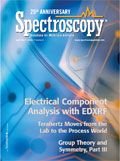Market Profile: Portable and Handheld Raman
Raman spectroscopy in general, and specifically, handheld and portable Raman, has developed very rapidly over the past decade due to technological developments that have unleashed the advantages of the technique. Portable/handheld Raman spectroscopy has gone from an insignificant market to the largest portable molecular spectroscopy technique in just a few years.
Raman spectroscopy in general, and specifically, handheld and portable Raman, has developed very rapidly over the past decade due to technological developments that have unleashed the advantages of the technique. Portable/handheld Raman spectroscopy has gone from an insignificant market to the largest portable molecular spectroscopy technique in just a few years.

Raman spectroscopy, like other molecular spectroscopy techniques, has the advantages of being nondestructive and providing instantaneous analysis. Its biggest advantages over other techniques include being able to analyze samples through glass and plastic. However, the optical technology to build even an effective and reliable laboratory-based Raman instrument largely did not exist until the mid-1980s, while modern holographic notch filters were not developed until around 1990. The combination of these improvements with the miniaturization and ruggedization of lasers and electronics has led to the proliferation of handheld and portable Raman instruments in the past several years.
The market for handheld and portable Raman instruments was less than $10 million in 2006. Fast-forward to the end of 2009, and the market has grown to more than $50 million, with no less than four new vendors entering the market space in the previous two years. While military, security, and first responders continue to be the largest markets for portable and handheld Raman, raw material inspection and final product QA/QC in the pharmaceuticals industry is a rapidly growing application, as is the technique's use in forensics and counterfeit analysis. The market should continue to see strong double-digit growth for the near future.
The foregoing data were based upon SDi's market analysis and perspectives report entitled Global Assessment Report, 10.5th Edition: The Laboratory Life Science and Analytical Instrument Industry, August 2009. For more information, contact Stuart Press, Vice President – Strategic Analysis, Strategic Directions International, Inc., 6242 Westchester Parkway, Suite 100, Los Angeles, CA 90045, (310) 641-4982, fax: (310) 641-8851, www.strategic-directions.com.

Portable and Wearable Spectrometers in Our Future
December 3rd 2024The following is a summary of selected articles published recently in Spectroscopy on the subject of handheld, portable, and wearable spectrometers representing a variety of analytical techniques and applications. Here we take a closer look at the ever shrinking world of spectroscopy devices and how they are used. As spectrometers progress from bulky lab instruments to compact, portable, and even wearable devices, the future of spectroscopy is transforming dramatically. These advancements enable real-time, on-site analysis across diverse industries, from healthcare to environmental monitoring. This summary article explores cutting-edge developments in miniaturized spectrometers and their expanding range of practical applications.
Q&A: Portable FT-IR Empowers On-Site Food Quality Assurance
February 1st 2024Exploring the transformative capabilities of handheld Fourier transform infrared (FT-IR) spectrometers, Luis Rodriguez-Saona of The Ohio State University emphasizes their pivotal role in ensuring food integrity and safety across the entire supply chain.
Portable Raman Spectrometers: How Small Can They Get?
June 1st 2023There is a growing desire among spectroscopists for having instruments small enough to be taken to the sample, as opposed to bringing the sample to the instrument. The result is that Raman spectrometers are becoming more miniaturized. Because these instruments come at a lower cost and offer distinct advantages over traditional spectrometers, the expectation is that a rapid expansion of when these instruments are applied will come forthwith. We offer a preview of how future miniaturized Raman spectrometers might look.